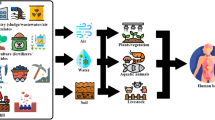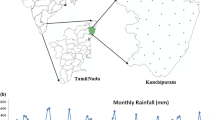Abstract
One hundred thirty boreholes of volcanic aquifers in rural Yemen Highland Groundwaters (YHGs) were chemically investigated to assess the suitability of water for drinking. Focus is to identify inorganic constituents of significant risk to health that occur in groundwaters of this area. Results showed that a number of boreholes contain, apart from fluoride, levels of nitrate, some heavy metals, total dissolved solids, and sulfates that could pose a health risk for consumers. The lateral variations of major ions with depth varied within the same aquifer based on the dynamic equilibrium of groundwater and hydrogeological conditions. The main inorganic groundwater contaminant in volcanic YHG is fluoride which is attributed to groundwater lithology and water type. Fluoride appears high in Ca-poor groundwater and where cation exchanges of Ca for Na are dominant. High F concentration in YHG is an extension of East African fluoride-rich groundwater. Majority of tube wells show that Fe concentration exceeds WHO guideline many folds. Much of the iron and manganese in groundwaters are naturally occurring, since the source rocks are enriched in ferromagnesian minerals. NO −3 and Cl− concentrations that have been detected in some wells may indicate sewage and/or agricultural runoff. Elevated concentration of chemical constituents in groundwater is a sign of groundwater degradation.
Abstract
تم فحص 130 بئر جوفي في المناطق الواقعة ضمن الإطار الجغرافي لبركانيات اليمن كيميائيا لغرض تقييم صلاحية هذه المياه للشرب. تم التركيز علي العناصر الغير عضوية المتركزة في المياه الجوفية لهذه المناطق والتي تشكل خطورة علي الصحة. أشارت النتائج إلي أن هناك العديد من الآبار تحتوي علي نسب عالية من ،النترات، الكلور، وارتفاع في المكونات الصلبة الذائبة ناهيك عن مستويات الفلور والفلزات الثقيلة المرتفعة. التباين الرأسي والأفقي في تركيز الأيونات يعود إلي التوازن الديناميكي للمياه في الخزان وكذا إلي طبيعة الخزان الجيولوجية. يعتبر عنصر الفلور هوا لملوث الرئيس في مناطق المرتفعات الريفية وعزي ذلك إلي طبيعة الصخور الحاوية ونوعية المياه السائدة. تبين أن الفلور في المياه الجوفية مرتبط بالكالسيوم ويبرز عندما تكون المياه فقيرة في الكالسيوم وحيثما يكون التبادل الأيوني للكالسيوم بالصوديوم في مستوياته العلياء. زيادة نسبة الفلور في مناطق المرتفعات هو استمرار لنفس الظاهرة المنتشرة في مناطق الصدع الأفريقي. أظهرت غالبية الآبار تراكيز عالية في نسبة عنصر الحديد تفوق دليل منظمة الصحة العالمية لمياه الشرب وعزي ذلك إلي توفر المعادن الغنية بالحديد والمغنسيوم في صخور المصدر. أظهرت بعض الآبار نسب عالية من النترات والكلور لتؤكد وجود مصادر خارجية للتلوث يتمثل في مخلفات المجاري والراجع من عمليات الري. الزيادة في نسب العناصر الكيميائية في المياه الجوفية يمكن أن يكون مؤشر علي التدهور في نوعية المياه.











Similar content being viewed by others
References
Al-Sakkaf RA (1996) Sustainable groundwater resources management in Sa’adah plain, Yemen, M.Sc. thesis, Delft, The Netherlands
Al-Shaibani S (2008) Human health and environment challenges-Yemen, Doha. www.FulbrightAcademy.org/www.qf.org.qa
Applin KR, Zhao N (1989) The kinetics of Fe (II) oxidation and well encrustation. Ground Water 27:168–174
Ayenew T (2006) Major ions composition of the groundwater and surface water systems and their geological and geochemical controls in the Ethiopian volcanic terrain. SINET Ethiopian J Sci 28:171–188
Ayenew T (2008) The distribution and hydrogeological controls of fluoride in the groundwater of central Ethiopian rift and adjacent highlands. Environ Geol 54:1313–1324
Barraclough D, Gardner CMK, Wellings SR, Cooper JD (1994) A tracer investigation into the importance of fissure flow in the unsaturated zone of the British Upper Chalk. J Hydrol 156:459–469
Berner RA (1971) Principles of chemical sedimentology. McGraw Hill, New York, p 240
Bôhlke JK (2002) Groundwater recharge and agricultural contamination. Hydrogeol J 10:153–179. doi:10.1007/s10040-0183-3
British Geological Survey (2003) Water quality fact sheet: nitrate. Produced for WaterAid, London
Bugaisa SL (1971) Significance of fluorine in Tanzania drinking water. In: Proceedings of the Conference of Rural Water Supply in East Africa. Dar-es-Salam, pp 107–113
Chernet T, Travi Y (1993) Preliminary observations concerning the genesis of high fluoride contents in the Ethiopian Rift. In: Thorweiche U, Schandlmeier H (eds) Geoscientific research in northeast Africa, vol 8. Balkema, Rotterdam, pp 651–654
Chernet T, Travi Y, Valles V (2001) Mechanism of degradation of the quality of natural water in the lakes region of the Ethiopian rift valley. Water Res 35:2819–2832
Chilton J, Seiler KP (2006) Groundwater occurrence and hydrogeological environments. In: Schmoll O, Hoard G, Chilton J, Chorus I (eds) Protecting groundwater for health (WHO). IWA, London
Davidson I, Al-Kadasi M, Al-Khirbash S, Al-Subbary AK, Baker J, Blakey S, Bosence D, Dart C, Heaton R, McClay K, Menzies M, Nichols G, Owen L, Yelland A (1994) Geological evolution of the southeastern Red Sea rift margin, Republic of Yemen. Bull Geol Soc Am 106:1471–1493
Davis JA, Kent DB (1990) Surface complexation modeling in aqueous geochemistry. Rev Miner 23:177–260
Dissanayake CB (1991) The fluoride problem in the groundwater of Sri Lanka-environmental management and health. Int J Environ Stud 38:137–156
Dock L, Vahter M (1999) Metal toxicology. In: Ballantyne B, Marrs T, Syversen T (eds) General and applied toxicology. Macmillan Reference Ltd, London, pp 2065
Drever JI (1997) The geochemistry of natural waters, 3rd edn. Prentice Hall, Upper Saddle River
Dudal R (1957) Paddy soils. Presented at the first South East Asian soils conference, Manila, December 1957
Fara M, Chandrasekharam D, Minissale A (1999) Hydrogeochemistry of Damt thermal springs, Yemen Republic. Geothermics 28:241–252
Flaten TP, Steinnes E (1999) Soil and fresh waters. In: Ballantyne B, Marrs T, Syversen T (eds) General and applied toxicology, vol 2, 2nd edn. Macmillan Reference, London
Gaciri SJ, Davies TC (1993) The occurrence and geochemistry of fluoride in some natural waters of Kenya. J Hydrol 143:395–412
Gizaw B (1996) The origin of high bicarbonate and fluoride concentrations in waters of the Main Ethiopian Rift Valley, East African Rift System. J Afr Earth Sci 22:391–402
Greake AK, Foste SS (1989) Sequential isotope and solute profiling of the unsaturated zone of the British Chalk. Hydrol Sci J 34:79–95
Hack Comp (2004) Spectrophotometer procedure manual (D/R 2400). Hack, Loveland
Hadwen P (1975) Fluoride in groundwater in Ethiopia. Geological Survey of Ethiopia. Unpublished report
Handa BK (1975) Geochemistry and genesis of fluoride-containing ground waters in India. Ground Water 13:275–281
Hem JD (1970) Study and interpretation of the chemical characteristics of natural water. USGS, Water Supply Paper 1473
Hem JD (1989) Study and interpretation of the chemical characteristics of natural water, 3rd edn. USGS, Water Supply Paper 2254
Hutchinson FE (1970) Environmental pollution from highway deicing compounds. J Soil Water Conserv 25:144–146
IARC (1980) IARC monographs on the evaluation of carcinogenic risk of chemicals to man, vol. 23: some metals and metallic compounds. International Agency for Research on Cancer, Lyon
Kilham P, Hecky RE (1973) Fluoride: geochemical and geological significance in East African water and sediments. Limnol Oceanogr 18:932–945
Kloos H, Teklehaimanot R (1999) Distribution of fluoride and fluorosis in Ethiopia and prospects or control. Trop Med Int Health 4:355. doi:10.1046/j.1365-3156.1999.00405.x
Laftouhi NE, Vanclooster M, Jalal M, Witam O, Aboufirassi M, Bahir M, Persoons E (2003) Groundwater nitrate pollution in the Essaouira Basin, Morocco. CR Geosci 335:307–317
Larsson I (1984) Groundwater in hard rocks. UNESCO, Paris
McNeely RN, Neimanis VP, Dwyer L (1979) Water quality sourcebook—a guide to water quality parameters. Inland Waters Directorate, Water Quality Branch, Ottawa 88p
Menzies M, Bosence D, El-Nakhal HA, Al-Khirbash S, Al-Kadasi MA, Al-Subbary A (1990) Lithospheric extension and the opening of the Red Sea: sediment-basalt relationship in Yemen. Terra Nova 2:340–350
Minissale A, Mattash MA, Vaselli O, Tassi F, Al-Ganad IN, Selmo E, Shawki NM, Tedesco D, Poreda R, Ad-Dukhain AM, Hazzae MK (2007) Thermal springs, fumaroles and gas vents of continental Yemen: their relation with active tectonics, regional hydrology and the country’s geothermal potential. Appl Geochem 22:799–820
Moller IJ, Pindborg JJ, Gedalia I, RoedPetersen B (1970) The prevalence of dental fluorosis in the people of Uganda. Arch Oral Biol 15:213–225
Moormann FR, Breeman NV (1978) Soil forming processes in aquatic rice lands. Rice: soil, water, land, chapter 5. International Rice Research Institute, Philippines
Morgan JJ, Stumm W (1991) Chemical processes in the environment, relevance of chemical speciation. In: Merien E (ed) Metals and their compounds in the environment. VCH, Germany, pp 67–103
Nanyaro JT, Aswathanarayana U, Mungure JS, Lahermo PW (1984) A geochemical model for the abnormal fluoride concentrations in waters in parts of northern Tanzania. J Afr Earth Sci 2:129–140
Nickson RT, McArther J, Burges W, Ahmed KM, Ravenscroft P, Rahman M (1998) Arsenic poisoning of Bangladesh groundwater. Nature 395:338
Nickson RT, McArther J, Ravenscroft P, Burges WG, Ahmed KM (2000) Mechanism of arsenic release to groundwater. Bangladesh and West Bengal. Appl Geochem 15:403–413
Norra S, Berner ZA, Agarwala P, Wagner F, Chandrasekharam D, Stuben D (2005) Impact of irrigation with arsenic rich groundwater on soil and crops: a geochemical case study in West Bengal Delta Plain, India. Appl Geochem 20:1890–1906
Ockerse T (1953) Chronic endemic dental fluorosis in Kenya, East Africa. Br Dent J 95:57–60
Smedley PL, Kinniburgh DG (2001) A review of the source behavior and distribution of arsenic in natural waters. App Geochem 17:517–568
Smith AH, Hopenhayn-Rich C, Bates MN, Goeden HM, Hertz-Picciotto I, Duggan HM, Wood R, Kosnett MJ, Smith MT (1992) Cancer risks from arsenic in drinking water. Environ Health Prospect 97:259–267
Stollenwerk KG (2003) Geochemical processes controlling transport of arsenic in groundwater: a review of adsorption. In: Welch AH, Stollenwerk KG (eds) Arsenic in groundwater: geochemistry and occurrence. Kluwer, Dordrecht, pp 67–100
Tebbutt TA (1983) Relationship between natural water quality and health. UNISCO, Paris
Teotia SP, Teotia M, Singh RK (1981) Hydrogeochemical aspects of endemic aspects of endemic skeletal fluorosis in India—an epidemiological study. Fluoride 14:69–74
Tesorieroa AJ, Spruilla TB, Eimersb JL (2004) Geochemistry of shallow groundwater in coastal plain environments in the southeastern United States; implications for aquifer susceptibility. Appl Geochem 19:1471–1482
UNICEF (2005) UNICEF’S position on water fluoridation, water environment & sanitation, fluoride in water: an overview. http://www.nofluoride.com/unicef_fluor.htm. Accessed 26 May 2005
Weinstein LH, Davison A (2004) Fluorides in the environment, effects on plants and animals. CABI, Wallingford
Wellings SR (1984) Recharge of the upper chalk aquifer at a site in Hampshire, England. J Hydrol 69:275–285
White AF, Benson SM, Yee AW, Wollenberg HA, Flexser S (1991) Groundwater contamination at the Kesterson Reservoir, California-geochemical parameters influencing selenium mobility. Water Resour Res 27:1085–1089
WHO (1993) Guidelines for drinking-water quality: recommendations, vol 1, 2nd edn. World Health Organization, Geneva
Williams WM, Nicholas JJ, Nungurrayi PB, Napurrula CR (1996) Paediatric urolithiasis in a remote Australian Aboriginal community. J Paediatr Child Health 32:344–346
WRAY-35 (1995) Water resources assessment of Yemen (report). Ministry of Civil and Mineral Resources, General Department of Hydrogeology
Zahid A, Hassan MQ, Blake K-D, Flegr M, Clark DW (2008) Groundwater chemistry and occurrence of arsenic in the Meghna floodplain aquifer, southeastern Bangladesh. Environ Geol 54:1247–1260
Zheng Y, Stute M, Van Geen A, Gavrieli I, Dhar R, Simpson HJ, Schlosser P, Ahmed KM (2004) Redox control of arsenic mobilization in Bangladesh groundwater. Appl Geochem 19:201–214
Acknowledgments
The author would like to thank Mr. Abdul Hamid Al-Sha’abi, Director, Rural Water Authority Laboratory, and his team for their unconditional assistance with the data extraction. The two anonymous reviewers provided very constructive and helpful comments which enabled a considerable improvement of the original draft. All interpretations and errors are my own.
Author information
Authors and Affiliations
Corresponding author
Rights and permissions
About this article
Cite this article
Al-Mikhlafi, A.S. Groundwater quality of Yemen volcanic terrain and their geological and geochemical controls. Arab J Geosci 3, 193–205 (2010). https://doi.org/10.1007/s12517-009-0068-7
Received:
Accepted:
Published:
Issue Date:
DOI: https://doi.org/10.1007/s12517-009-0068-7




